Mid-Century Daily Discharge Scenarios Based on Climate and Land Use Change in Ouémé River Basin at Bétérou Outlet
Abstract
1. Introduction
2. Materials and Methods
2.1. Study Area
2.2. Data
2.2.1. Climate Scenarios
2.2.2. Land Use/Cover Scenario
2.2.3. Other Data
| inverse relative distance Earth–Sun | |
| sunset hour angle | |
| solar declination | |
| the latitude |
2.3. Methods
2.3.1. LISFLOOD Description
2.3.2. LISFLOOD Calibration and Validation
3. Results and Discussion
3.1. Model Calibration and Validation Results
3.2. Daily Discharge Scenarios
4. Conclusions
Author Contributions
Funding
Acknowledgments
Conflicts of Interest
References
- Vos, F.; Rodriguez, J.; Below, R.; Guha-Sapir, D. Annual Disaster Statistical Review 2009, The Numbers and Trends; Centre for Research on the Epidemiology of Disasters: Brussels, Belgium, 2010. [Google Scholar]
- Mills, E. Insurance in a climate of change. Science 2005, 309, 1040–1044. [Google Scholar] [CrossRef] [PubMed]
- IPCC. Managing the Risks of Extreme Events and Disasters to Advance Climate Change Adaptation; Field, C.B., Barros, V., Stocker, T.F., Qin, D., Dokken, D.J., Ebi, K.L., Mastrandrea, M.D., Mach, K.J., Plattner, G.-K., Allen, S.K., et al., Eds.; Cambridge University Press: Cambridge, UK, 2012. [Google Scholar]
- Di Baldassarre, G.; Montanari, A.; Lins, H.; Koutsoyiannis, D.; Brandimarte, L.; Blöschl, G. Flood fatalities in Africa: From diagnosis to mitigation. Geophys. Res. Lett. 2010. [Google Scholar] [CrossRef]
- Bates, B.C.; Kundzewicz, Z.W.; Wu, S.; Palutikof, J.P. Climate Change and Water; Technical Paper of the Intergovernmental Panel on Climate Change; IPCC: Geneva, Switzerland, 2008. [Google Scholar]
- Mbaye, M.L.; Hagemann, S.; Haensler, A.; Gaye, A.T.; Afouda, A. Assessment of Climate Change Impact on Water Resources in the Upper Senegal Basin (West Africa). Am. J. Clim. Chang. 2015. [Google Scholar] [CrossRef]
- Diekkrüger, B.; Diederich, M.; Giertz, S.; Höllermann, B.; Kocher, A.; Reichert, B.; Steup, G. Water availability and water demand under Global Change in Benin, West Africa. In Proceedings of the Global Change and Water Resources in West Africa The German-African GLOWA Projects, Ouagadougou, Burkina Faso, 25–28 August 2008. [Google Scholar]
- Giertz, S.; Höllermann, B.; Diekkrüger, B. An interdisciplinary scenario analysis to assess the water availability and water consumption in the Upper Ouémé catchment in Benin. Adv. Geosci. 2006, 9, 3–13. [Google Scholar] [CrossRef]
- Bossa, A.Y.; Diekkrüger, B.; Agbossou, E.K. Scenario-Based Impacts of Land Use and Climate Change on Land and Water Degradation from the Meso to Regional Scale. Water 2014, 6, 3152–3181. [Google Scholar] [CrossRef]
- Hounkpè, J. Assessing the Climate and Land Use Changes Impact on Flood Hazard in Ouémé River Basin, Benin (West Africa); University of Abomey Calavi: Abomey Calavi, Benin, 2016. [Google Scholar]
- Giorgi, F.; Jones, C.; Asrar, G. Addressing climate information needs at the regional level: The CORDEX framework. World Meteorol. Org. Bull. 2009, 58, 175–183. [Google Scholar]
- Kaboré, E.; Nikiema, M.; Ibrahim, B.; Helmschrot, J. Merging historical data records with MPI-ESM-LR, CanESM2, AFR MPI and AFR 44 scenarios to assess long-term climate trends for the Massili Basin in central Burkina Faso. Int. J. Curr. Eng. Technol. 2015, 5, 1846–1852. [Google Scholar]
- N’Tcha M’Po, Y.; Lawin, A.E.; Oyerinde, G.T.; Yao, K.B.; Afouda, A.A. Comparison of Daily Precipitation Bias Correction Methods Based on Four Regional Climate Model Outputs in Ouémé Basin, Benin. Hydrology 2016, 4, 58–71. [Google Scholar] [CrossRef]
- Amengual, A.; Homar, V.; Romero, R.; Alonso, S.; Ramis, C. A Statistical Adjustment of Regional Climate Model Outputs to Local Scales: Application to Platja de Palma, Spain. J. Clim. 2012. [Google Scholar] [CrossRef]
- Obada, E.; Alamou, A.E.; Zandagba, E.J.; Biao, I.E.; Chabi, A.; Afouda, A.A. Comparative study of seven bias correction methods applied to three Regional Climate Models in Mekrou catchment (Benin, West Africa). Int. J. Curr. Eng. Technol. 2016, 6, 1831–1840. [Google Scholar]
- RIVERTWIN. Regional Model for Integrated Water Management inTwinned River Basins. Adapted and Integrated Model for the Ouémé River Basin; Institute for Landscape Planning and Ecology: Stuttgart, Germany, 2007. [Google Scholar]
- Götzinger, J. Distributed Conceptual Hydrological Modelling—Simulation of Climate, Land Use Change Impact and Uncertainty Analysis. Ph.D. Thesis, University of Stuttgart, Stuttgart, Germany, 2007. [Google Scholar]
- Aguilar, C.; Polo, M.J. Generating reference evapotranspiration surfaces from the Hargreaves equation at watershed scale. Hydrol. Earth Syst. Sci. 2011, 15. [Google Scholar] [CrossRef]
- Allen, R.G.; Pereira, L.S.; Raes, D.; Smith, M. FAO Irrigation and Drainage Paper No. 56: Crop Evapotranspiration (Guidelines for Computing Crop Water Requirements); FAO: Rome, Italy, 1998. [Google Scholar]
- Maidment, R.D. Handbook of Hydrology; McG Raw-Hill Inc.: New York, NY, USA, 1992. [Google Scholar]
- Jarvis, A.; Reuter, H.I.; Nelson, A.; Guevara, E. Hole-Filled Seamless SRTM Data V4; International Centre for Tropical Agriculture (CIAT): Cali, Colombia, 2008. [Google Scholar]
- Gessner, U.; Niklaus, M.; Kuenzer, C.; Dech, S. Intercomparison of Leaf Area Index Products for a Gradient of Sub-Humid to Arid Environments in West Africa. Remote Sens. 2013, 5, 1235–1257. [Google Scholar] [CrossRef]
- Komi, K.; Neal, J.; Trigg, M.A.; Diekkrüger, B. Modelling of flood hazard extent in data sparse areas: A case study of the Oti River basin. J. Hydrol. 2017, 10, 122–132. [Google Scholar] [CrossRef]
- Van der Knijff, J.; de Roo, A.P.J. LISFLOOD. Distributed Water Balance and Flood Simulation Model; Revised User Manual; JRC Scientific and Technical Reports; JRC: Brussels, Belgium, 2008. [Google Scholar]
- Mabande, P.K. Application of a Satellite Based Rainfall-Runoff Model for Large Scale Flood Simulation: A Case Study of Cuvelai Basin in Namibia; University of Twente: Enschede, The Netherlands, 2011. [Google Scholar]
- Koriche, S.A. Remote Sensing Based Hydrological Modeling for Flood Early Warning in the Upper and Middle Awash River Basin; University of Twente: Enschede, The Netherlands, 2012. [Google Scholar]
- Komi, K. Flood Risk Assessment in Poorly Gauged River Basins—A Case Study of the Oti River Basin, Togo, West Africa. Ph.D. Thesis, University of Abomey-Calavi, Abomey-Calavi, Benin, 2016. [Google Scholar]
- Thiemig, V.; Bisselink, B.; Pappenberger, F.; Thielen, J. A pan-African mediumrange ensemble flood forecast system. Hydrol. Earth Syst. Sci. 2015, 19. [Google Scholar] [CrossRef]
- Mahé, G. Surface/groundwater interactions in the Bani and Nakambe rivers, tributaries of the Niger and Volta basins, West Africa. Hydrol. Sci. J. 2009, 54, 704–712. [Google Scholar] [CrossRef]
- Mahé, G.; Dray, A.; Paturel, J.E.; Cres, A.; Koné, F.; Manga, M.; Crès, F.N.; Djoukam, J.; Maiga, A.A.H.; Ouédraogo, M.; et al. Climatic and anthropogenic impacts on the flow regime of the Nakambé River in Burkina. In Proceedings of the FRIEND 2002 Regional Hydrology: Bridging the Gap between Research and Practice, Cape Town, South Africa, 18–22 March 2002; pp. 69–76. [Google Scholar]
- Leduc, C.; Favreau, G.; Schroeter, P. Long terms rise in a Sahelien water-table: The continental Terminal in South-West Niger. J. Hydrol. 2001, 243, 43–54. [Google Scholar] [CrossRef]
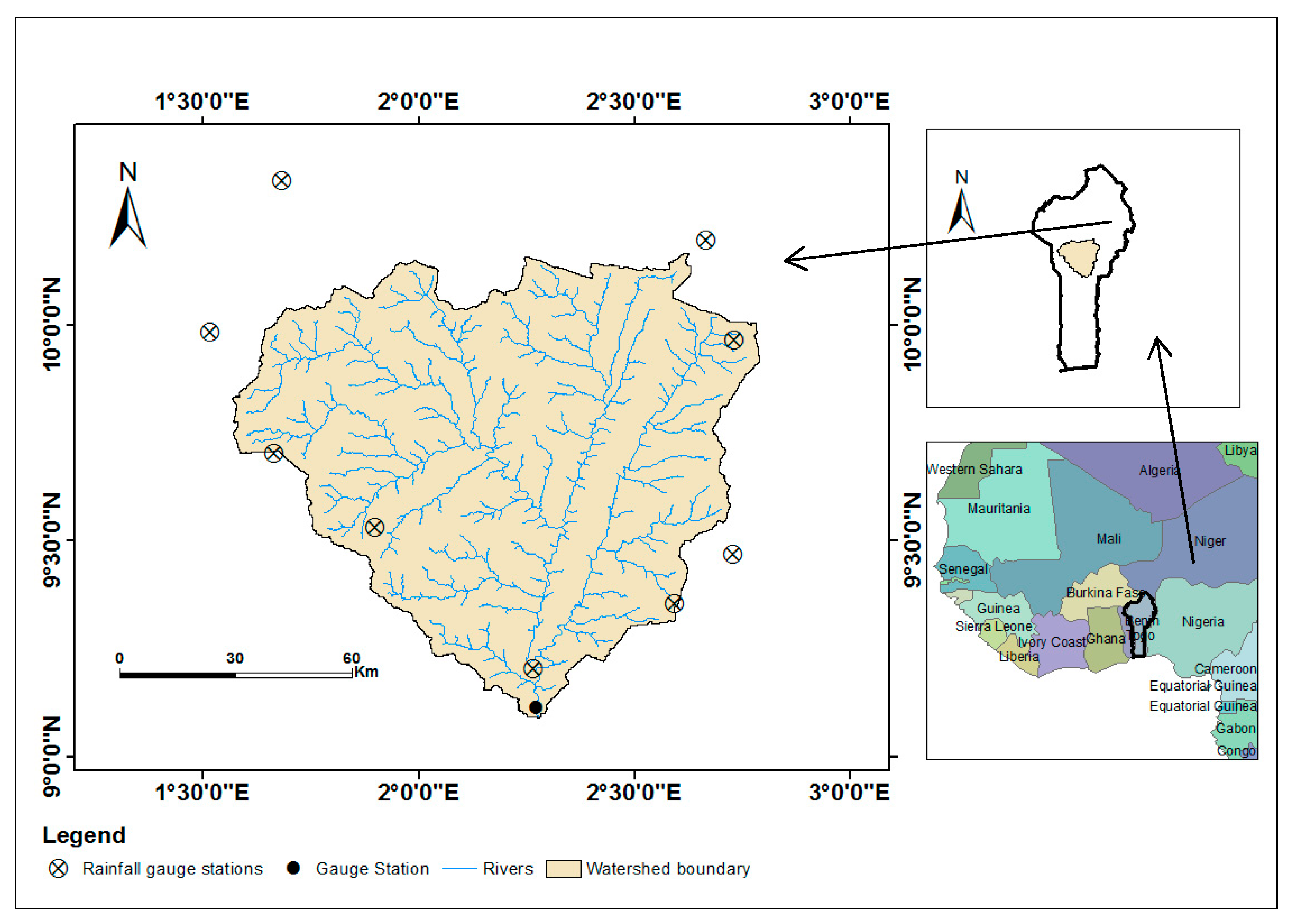
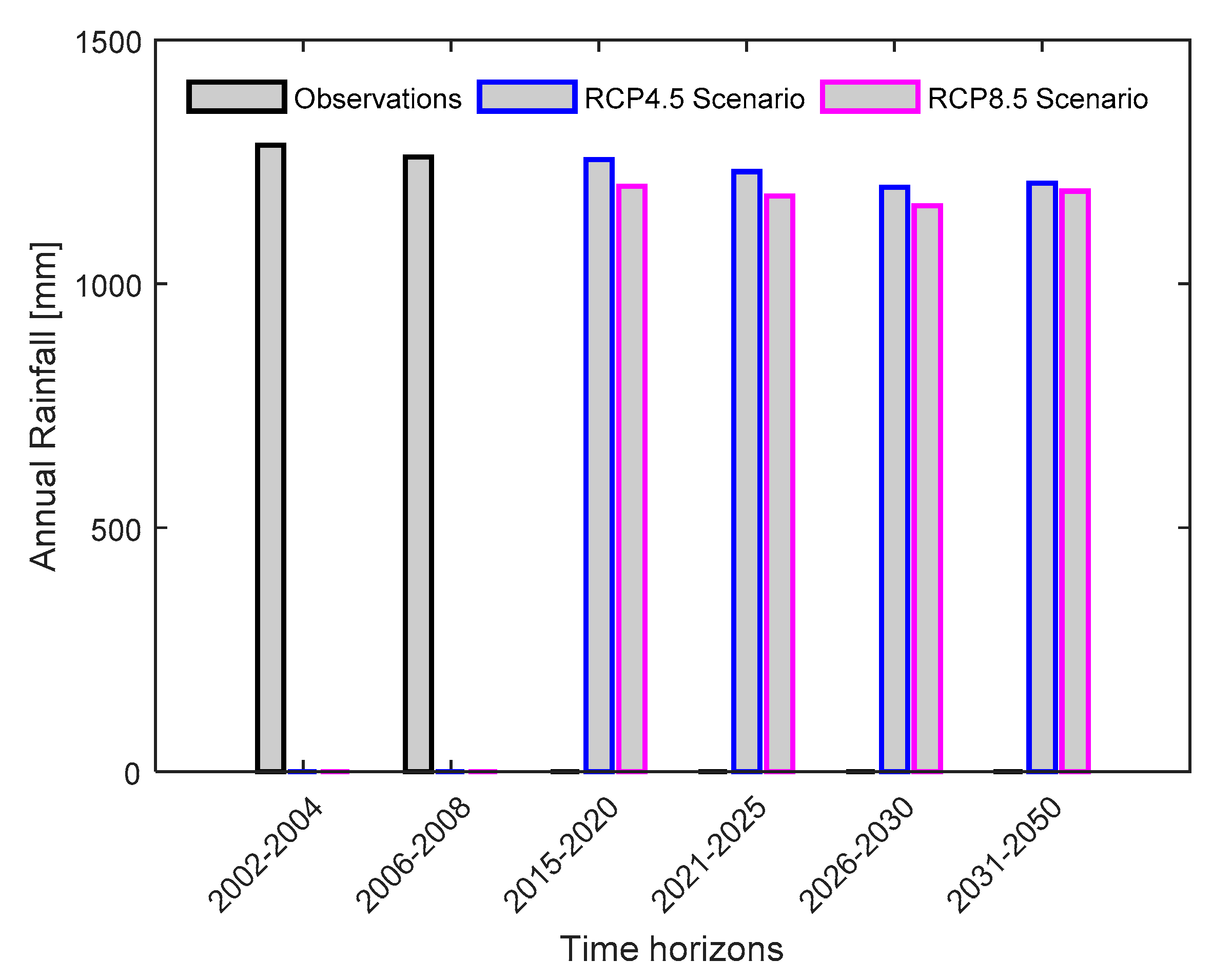
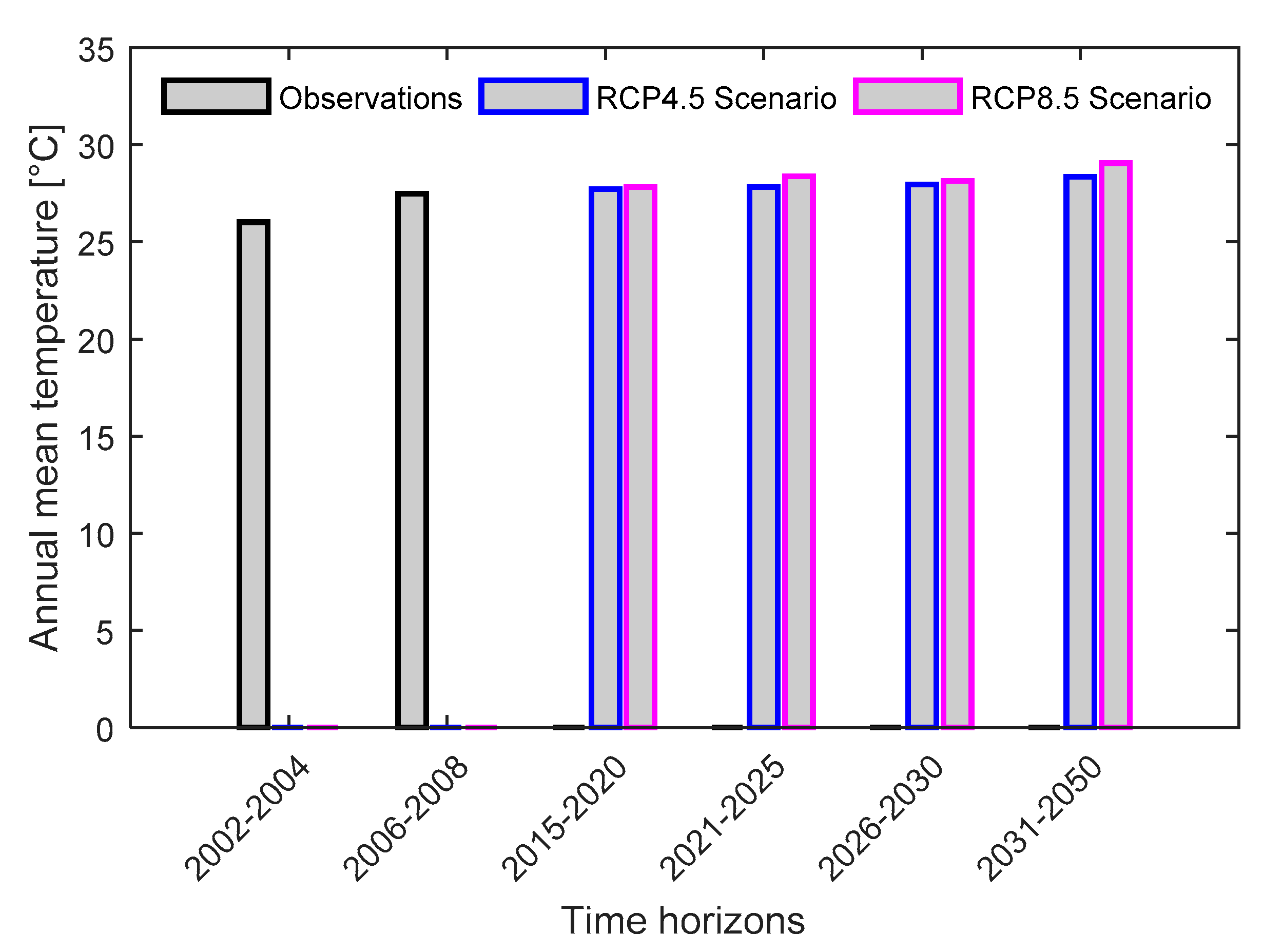
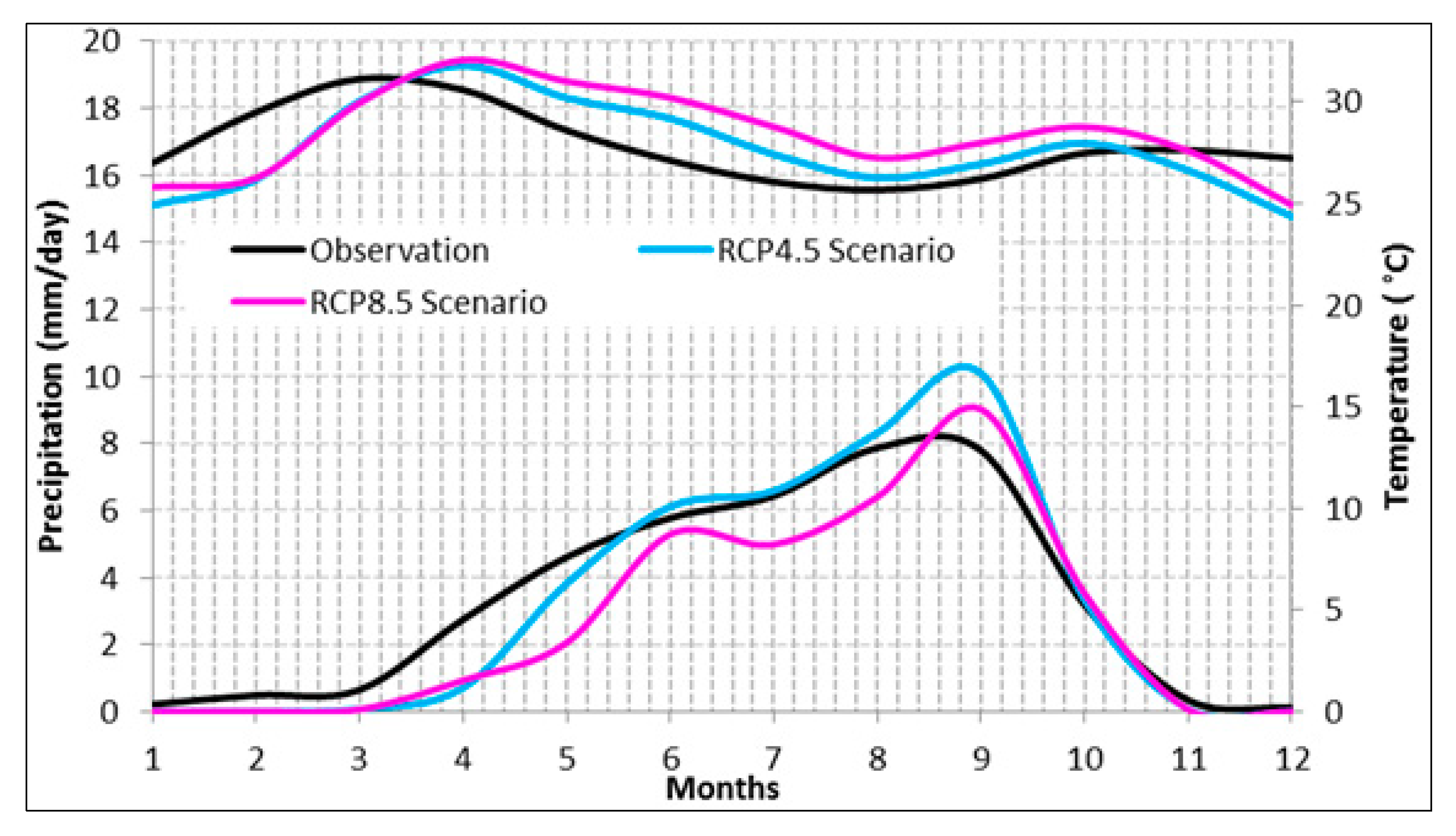
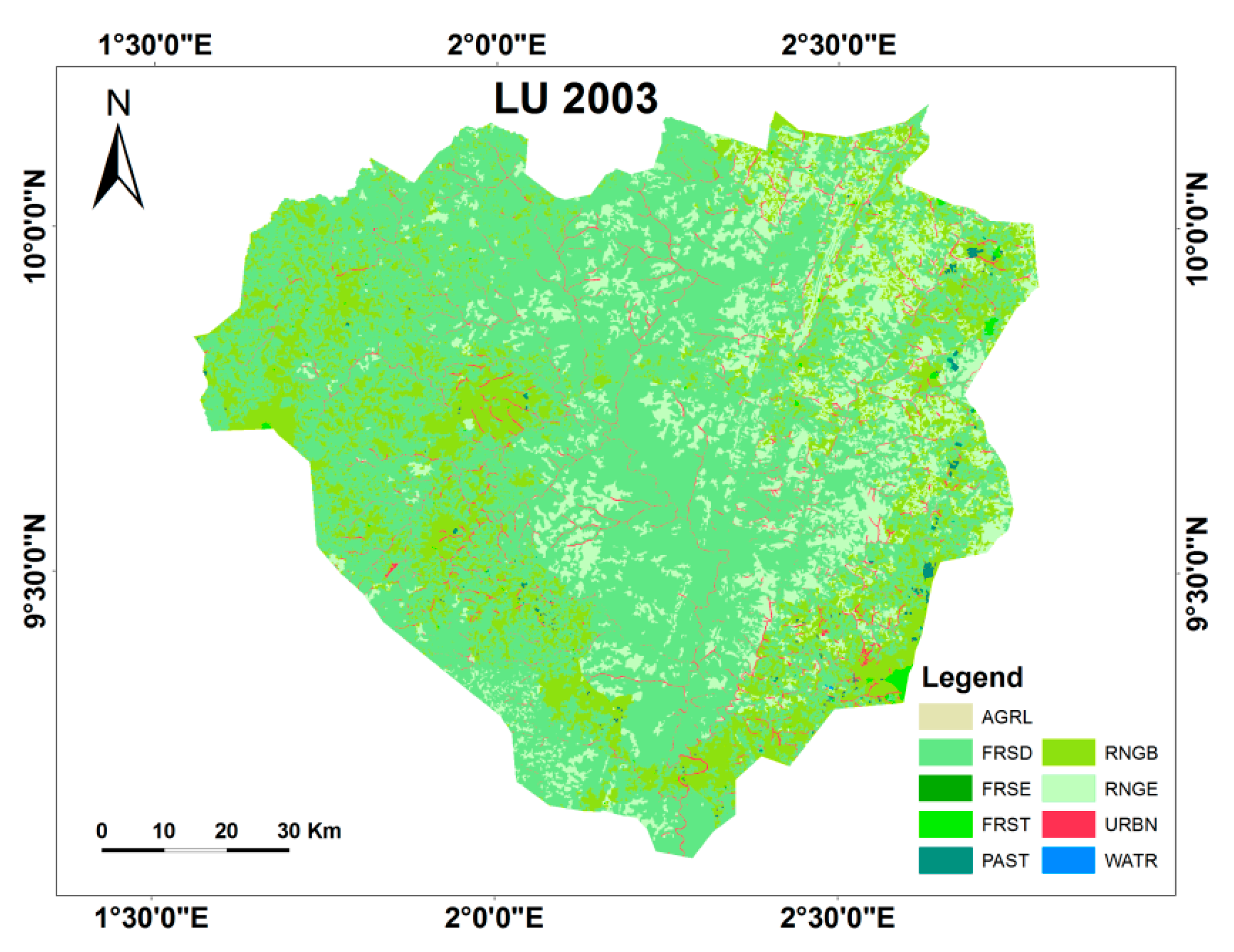
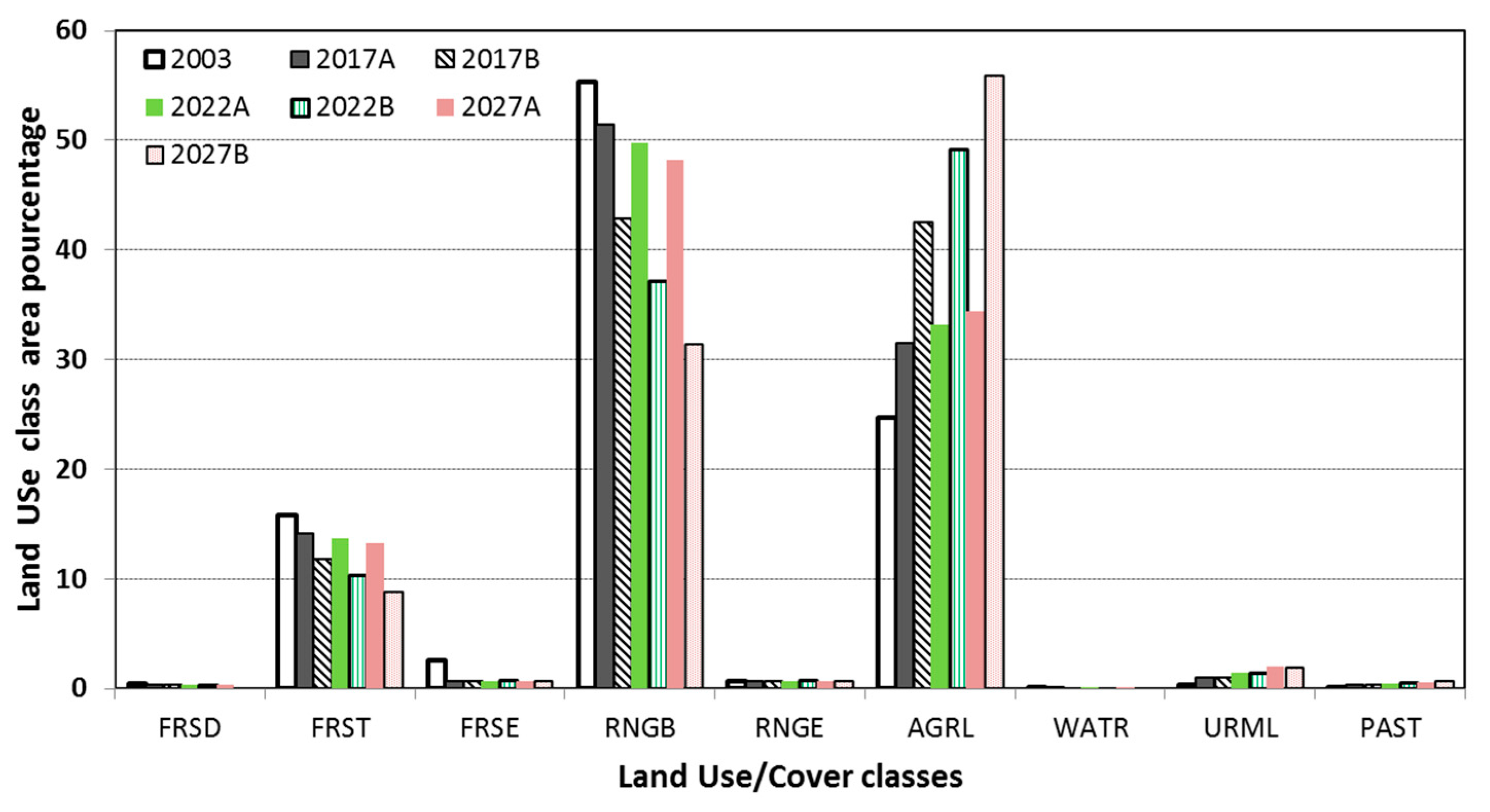
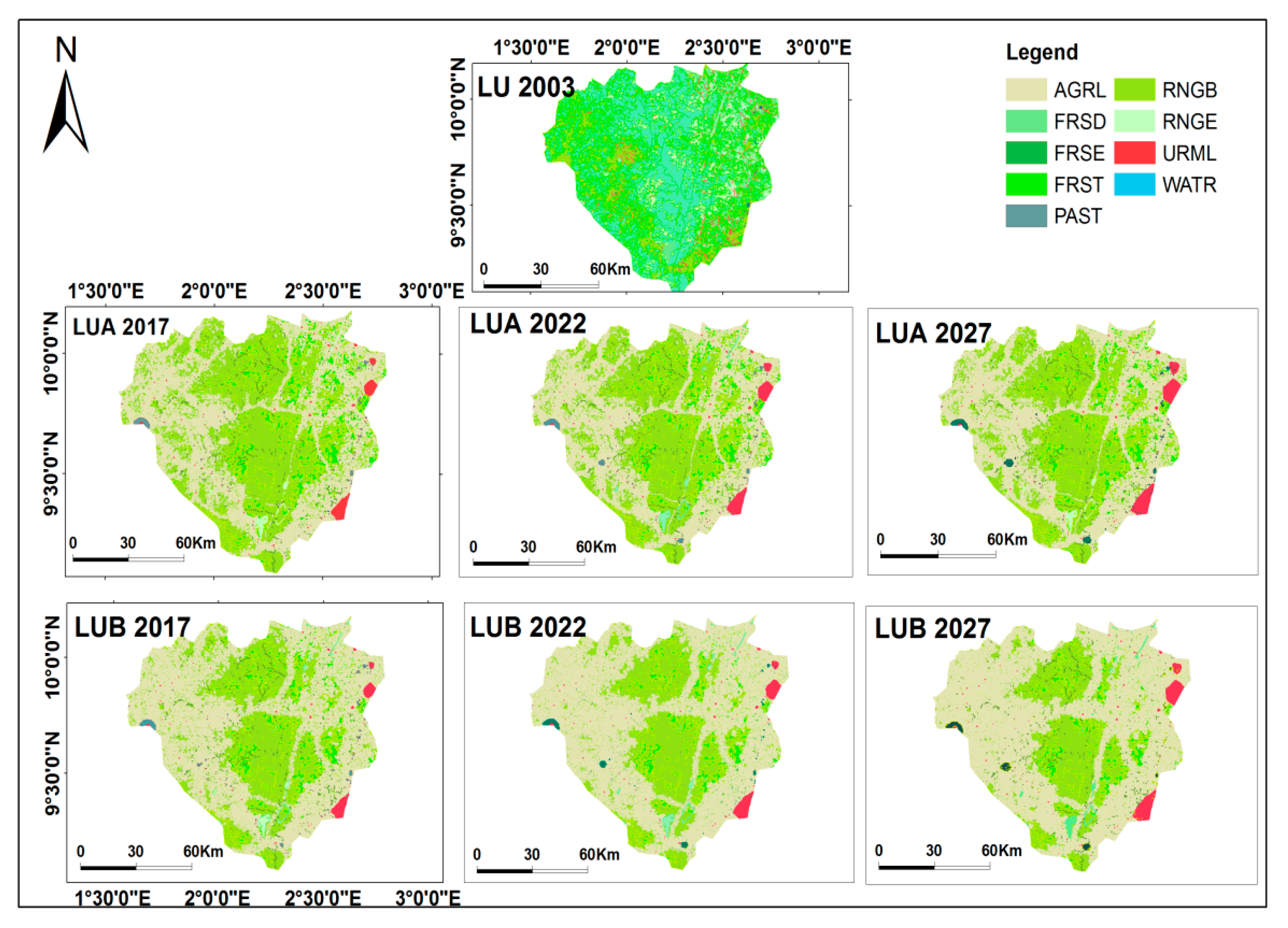

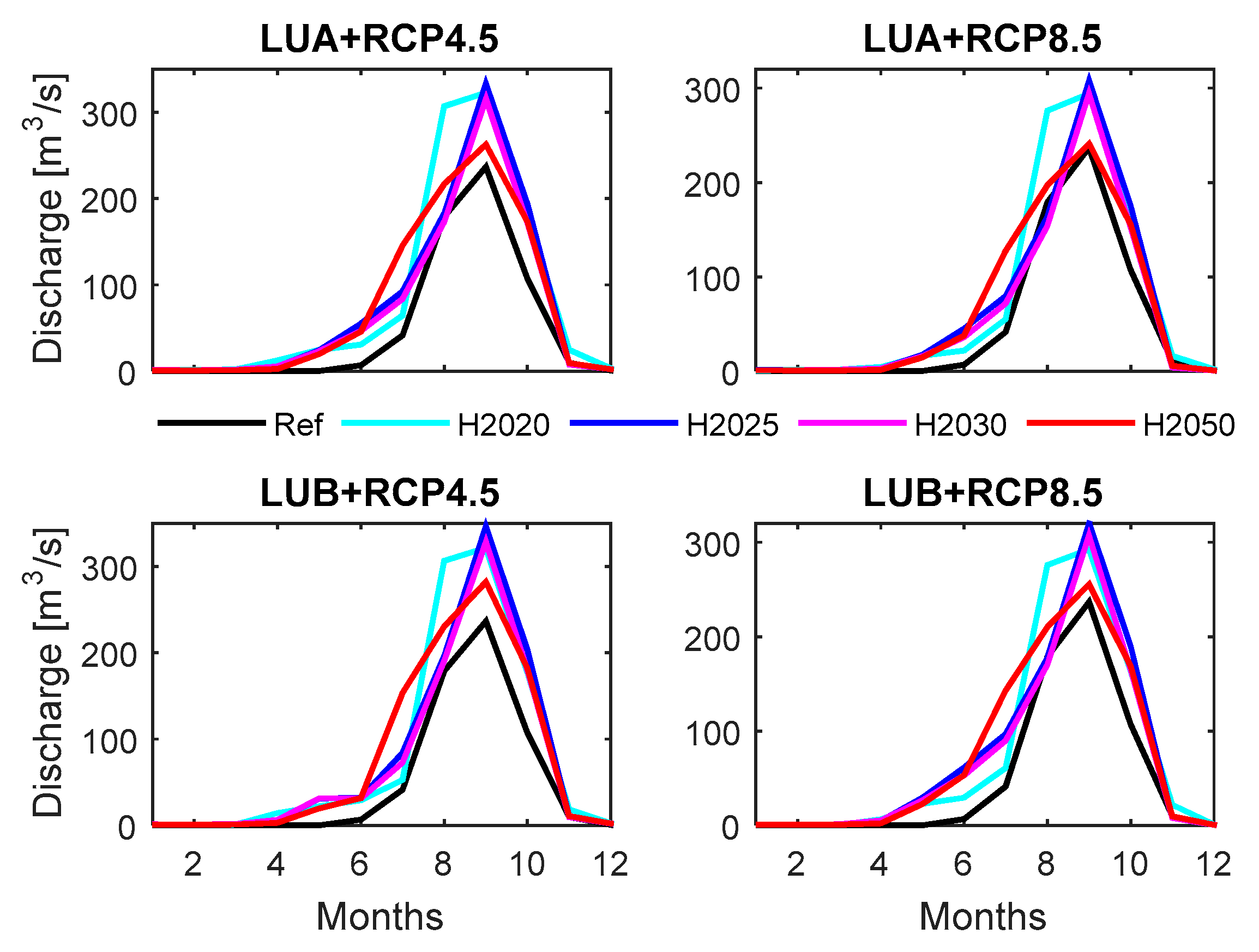
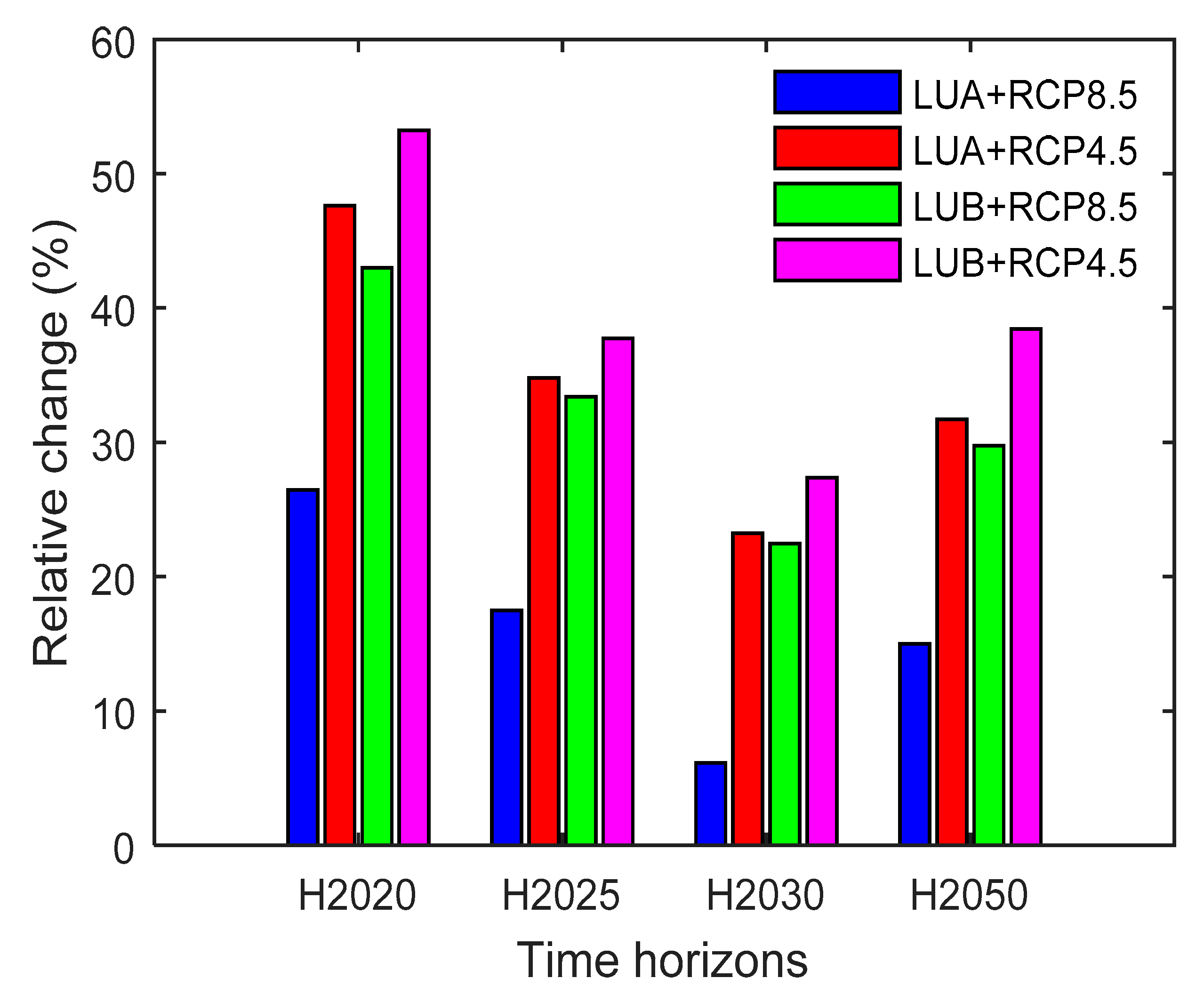
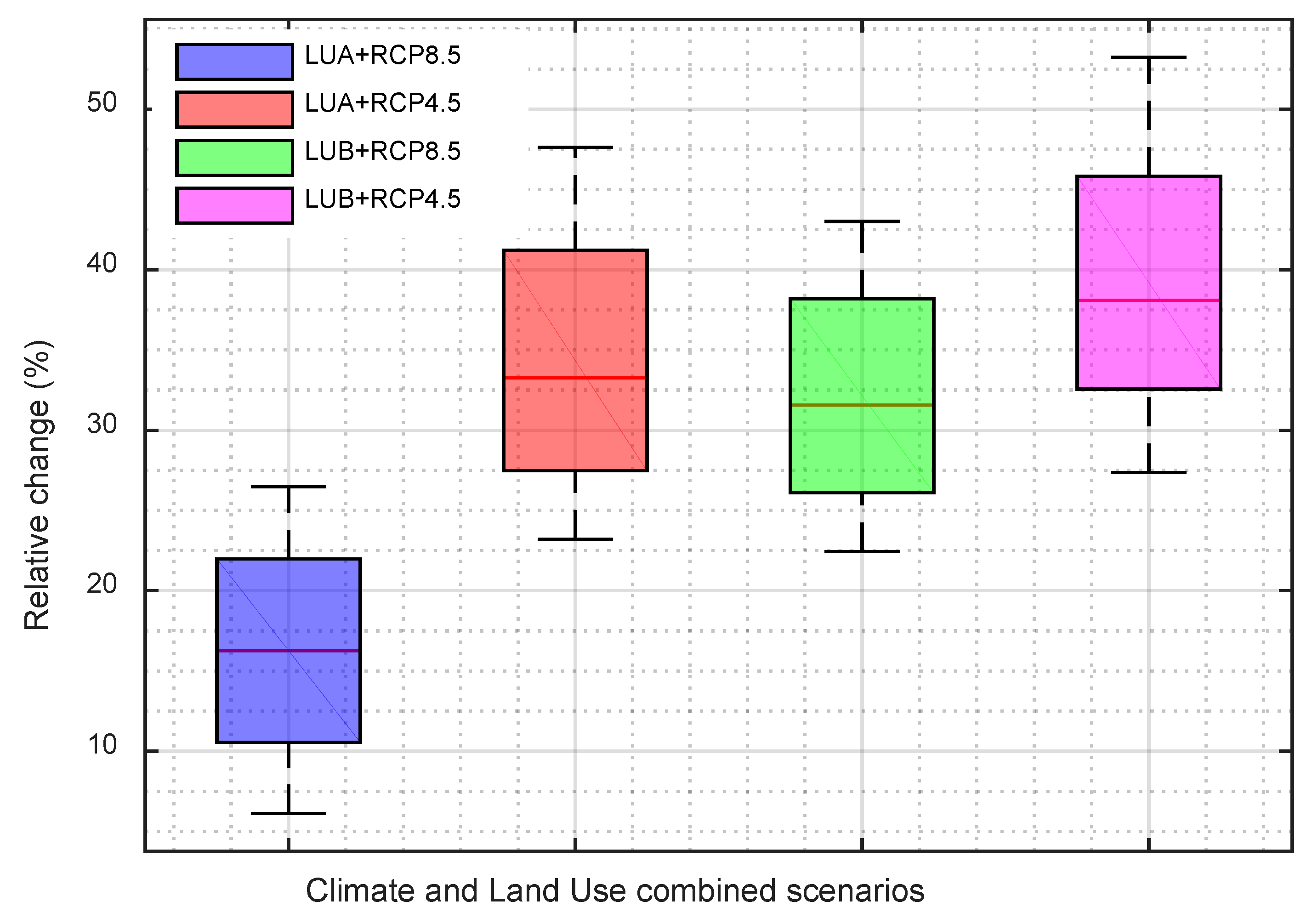
| Land Use Categories | Land Use Code | Area (km2) | Percentage of Total Area |
|---|---|---|---|
| Forest-deciduous | FRSD | 42.98 | 0.43 |
| Forest-mixed | FRST | 1580.14 | 15.68 |
| Range-brush | RNGB | 5515.72 | 54.74 |
| Agricultural Land-Generic | AGRL | 2459.27 | 24.41 |
| Forest-evergreen | FRSE | 261.74 | 2.60 |
| Range-grasses | RNGE | 72.89 | 0.72 |
| Residential | URML | 31.24 | 0.31 |
| RCP4.5 | RCP8.5 | |
|---|---|---|
| LUA | LUA + RCP4.5 | LUA + RCP8.5 |
| LUB | LUB + RCP4.5 | LUB + RCP8.5 |
| Calibration | Validation | ||
|---|---|---|---|
| RMSE [m3/s] | NSE [%] | RMSE [m3/s] | NSE [%] |
| 37.21 | 92% | 32.3 | 90.5% |
| Parameter Names | Optimum Value | Parameters Range * |
|---|---|---|
| Upper zone time constant | 5 | 1–50 |
| Lower zone time constant | 1100 | 50–5000 |
| Ground water percolation value | 0.35 | 0–1.5 |
| Xinanjiang parameter b | 0.8 | 0.1–1 |
| Power preferential flow | 2 | 1–6 |
© 2018 by the authors. Licensee MDPI, Basel, Switzerland. This article is an open access article distributed under the terms and conditions of the Creative Commons Attribution (CC BY) license (http://creativecommons.org/licenses/by/4.0/).
Share and Cite
Emmanuel, L.A.; N’Tcha M’Po, Y.; Biaou, C.A.; Komi, K.; Hounguè, R.; Yao, K.B.; Afouda, A.A. Mid-Century Daily Discharge Scenarios Based on Climate and Land Use Change in Ouémé River Basin at Bétérou Outlet. Hydrology 2018, 5, 69. https://doi.org/10.3390/hydrology5040069
Emmanuel LA, N’Tcha M’Po Y, Biaou CA, Komi K, Hounguè R, Yao KB, Afouda AA. Mid-Century Daily Discharge Scenarios Based on Climate and Land Use Change in Ouémé River Basin at Bétérou Outlet. Hydrology. 2018; 5(4):69. https://doi.org/10.3390/hydrology5040069
Chicago/Turabian StyleEmmanuel, Lawin Agnidé, Yèkambèssoun N’Tcha M’Po, Chabi Angelbert Biaou, Kossi Komi, Rita Hounguè, Kouassi Benjamin Yao, and Abel Akambi Afouda. 2018. "Mid-Century Daily Discharge Scenarios Based on Climate and Land Use Change in Ouémé River Basin at Bétérou Outlet" Hydrology 5, no. 4: 69. https://doi.org/10.3390/hydrology5040069
APA StyleEmmanuel, L. A., N’Tcha M’Po, Y., Biaou, C. A., Komi, K., Hounguè, R., Yao, K. B., & Afouda, A. A. (2018). Mid-Century Daily Discharge Scenarios Based on Climate and Land Use Change in Ouémé River Basin at Bétérou Outlet. Hydrology, 5(4), 69. https://doi.org/10.3390/hydrology5040069





